
QQQX
QQQX Nasdaq tokenized ETF (xStock)
| تریدر | نوع سیگنال | حد سود/ضرر | زمان انتشار | مشاهده پیام |
|---|---|---|---|---|
 AnabelSignalsRank: 159 | فروش | حد سود: تعیین نشده حد ضرر: تعیین نشده | 12/21/2025 | |
 UnitedSignalsRank: 374 | خرید | حد سود: تعیین نشده حد ضرر: تعیین نشده | 12/13/2025 | |
 RonnieV29Rank: 1067 | خرید | حد سود: تعیین نشده حد ضرر: تعیین نشده | 12/19/2025 | |
cryptoyoda1Rank: 1030 | خرید | حد سود: تعیین نشده حد ضرر: تعیین نشده | 12/16/2025 | |
 ContraryTraderRank: 2796 | خرید | حد سود: تعیین نشده حد ضرر: تعیین نشده | 12/7/2025 |
Price Chart of QQQX Nasdaq tokenized ETF (xStock)
سود 3 Months :
سیگنالهای QQQX Nasdaq tokenized ETF (xStock)
Filter
Sort messages by
Trader Type
Time Frame

UA_CAPITAL
QQQ (NQ-US100) Weekly Prediction – Outlook (21 DEC)
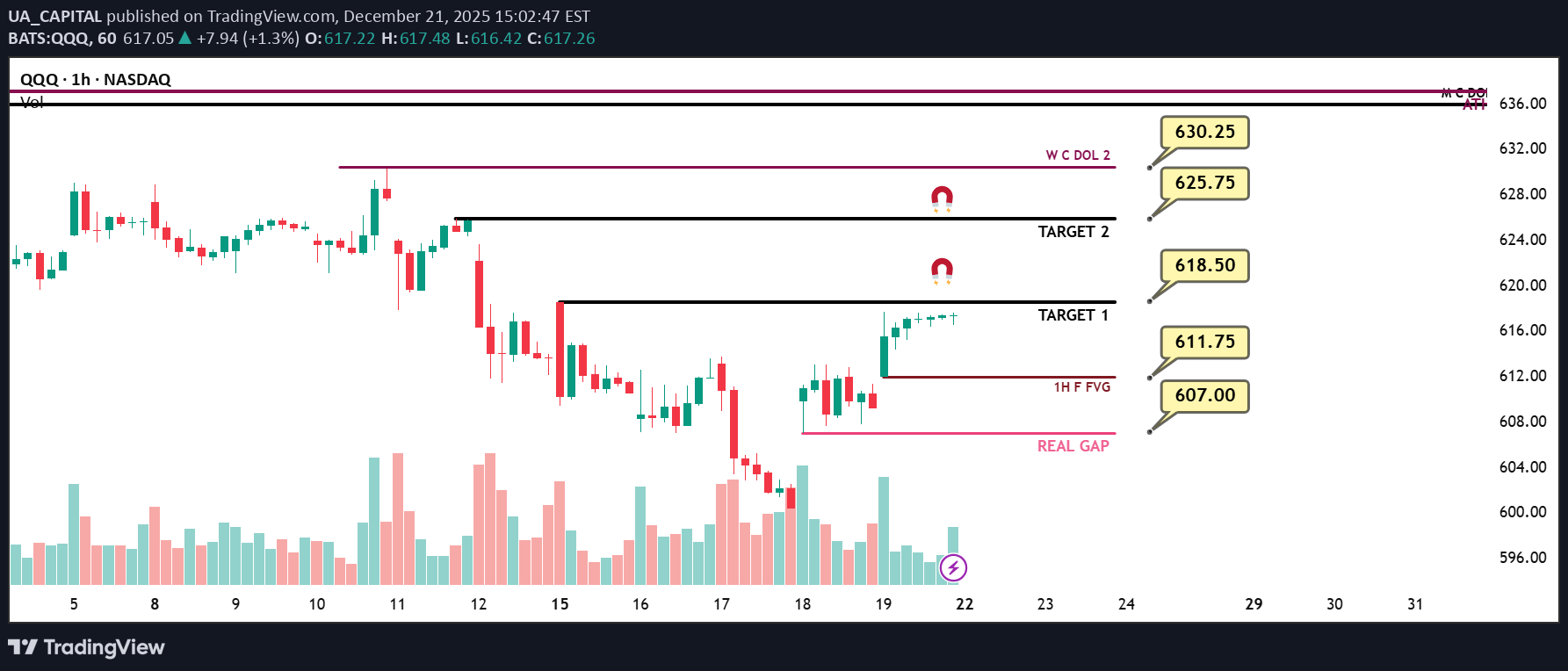
QQQ (NQ-US100) Weekly Prediction – Outlook (21 DEC) 📊 Market Sentiment Market sentiment turned fully bullish after the CPI data came in significantly lower than expected on Thursday. While the consensus expectation was 3.1%, the actual CPI print came at 2.7%, representing a meaningful downside surprise. This data does not directly determine the outcome of the January FED meeting, as another CPI report will be released on January 13, 2026, which will be far more critical for the FED’s decision making process. However, the current soft inflation trend increased the probability of another lower CPI reading in January, which positively impacted risk sentiment across markets. 📈 Technical Analysis Last week’s QQQ analysis played out perfectly. I hope you were able to capitalize on it. Price reversed precisely from the levels we anticipated following the CPI release. I am linking last week’s QQQ weekly analysis below for reference. After the CPI data, price transitioned back into a clean bullish structure on both the daily and weekly timeframes. On Friday, QQQ rallied impulsively and closed the week with strong bullish momentum. Overall, I think the market structure supports bullish continuation. 📌 Game Plan I think QQQ may directly test 618.5 (Target 1) early in the week, followed by a move toward 625.75. These are the two bullish targets I expect to be reached within this week. Price may also move toward these targets without any meaningful retracement. I plan to close one third of my call options at 618.5 and the remaining portion at 625.75 from the positions I am holding since Thursday. If price pulls back to 611.75 or 607 before reaching 625.75 and prints strong 1H or 4H bullish candle closes, I will look to add new call option positions targeting 625.75. In the event of a developing bearish structure, I will provide updates. However, at this stage, I do not see any clear bearish signals. 💬 For deeper sentiment and strategy insights, subscribe to my Substack free access available. This analysis is for educational purposes only and does not constitute financial advice. Always conduct your own research before trading or investing.Target 1 was perfectly hit at the open. I sold 1/3 of my call positions at 618.5, as I stated earlier. Im now waiting to see whether we get a retracement and a bounce to add more calls, targeting 625.75. However QQQ is the weaker instrument here so SPY is the better choice for call positions.
QQQ (19 December)
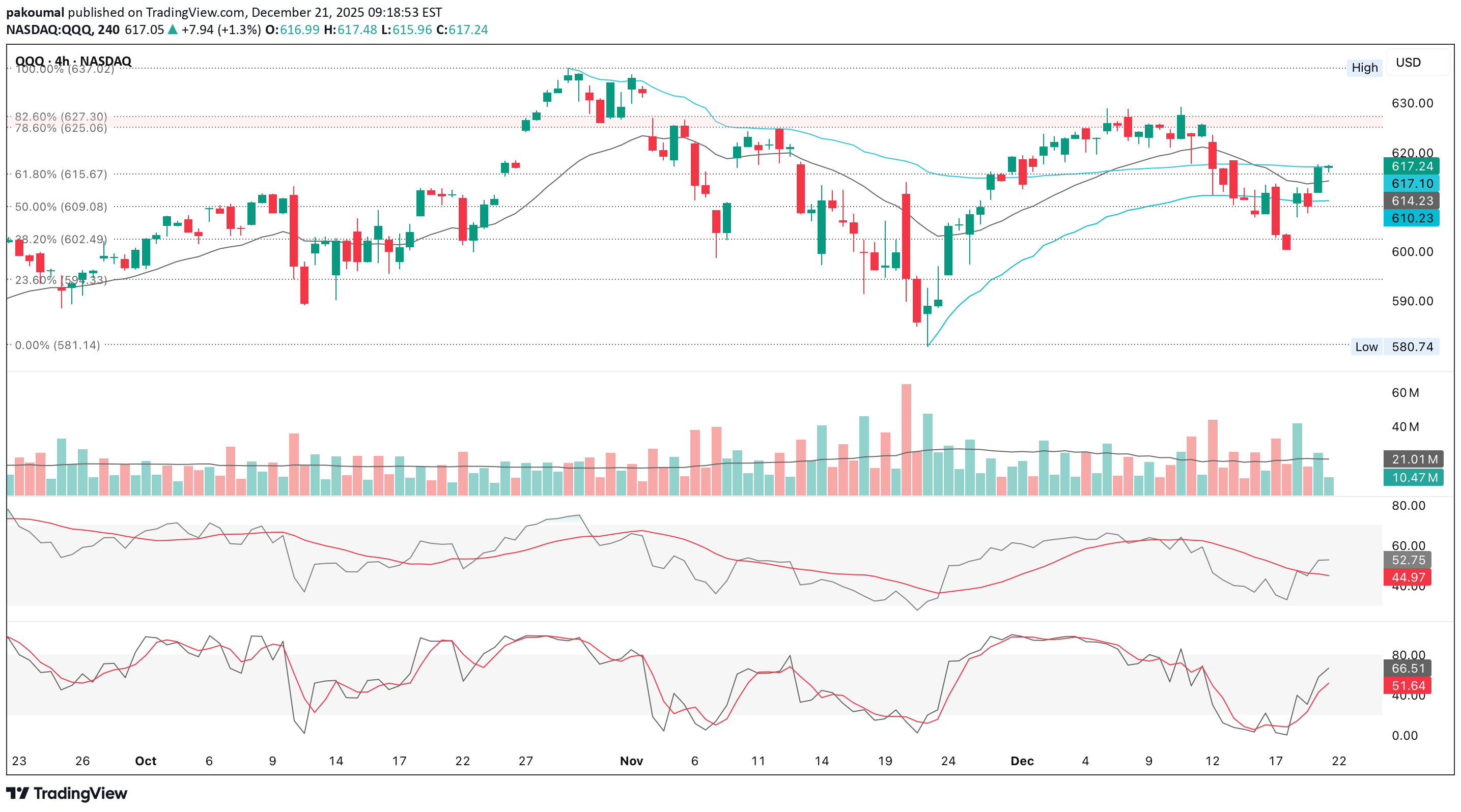
As long as QQQ holds $612, downside risk is fading & acceptance above $618 turns this from a bounce into a base Higher lows are forming from ~$600 to ~$612-$615 Price is holding above reclaimed value ($612-$615) across time frames This invalidates the immediate bearish breakdown scenario RSI is bullish continuation momentum, not mean-reversion Stoch is overbought on lower time frames, but it's not a sell signal unless price breaks support Momentum is supporting price, not diverging against it Volume expansion on the push through $612 No heavy sell-volume on pauses This is controlled buying, not short covering only which boosts the strength of the bounce 1. $615 is now critical support & must hold on pullbacks If price holds $615, the market is building a base 2. Expect chop at $618-$620 Rejection only matters if price falls back below $615 3. $625 If $620 breaks with acceptance, price likely moves here quickly This would strongly favor a bullish continuation 4. Loss of $615, then loss of $612 would put price back into balance/chop - not yet trend failure, but bad for short-dated calls As long as $615 holds, staying bullish is justified The market has shifted from risk of a bounce failure to building a base Bears lost control at $612 Bulls need $620+ to fully take it back Now it’s about whether momentum follows through quickly enough

AnabelSignals
QQQ Trading Opportunity! SELL!
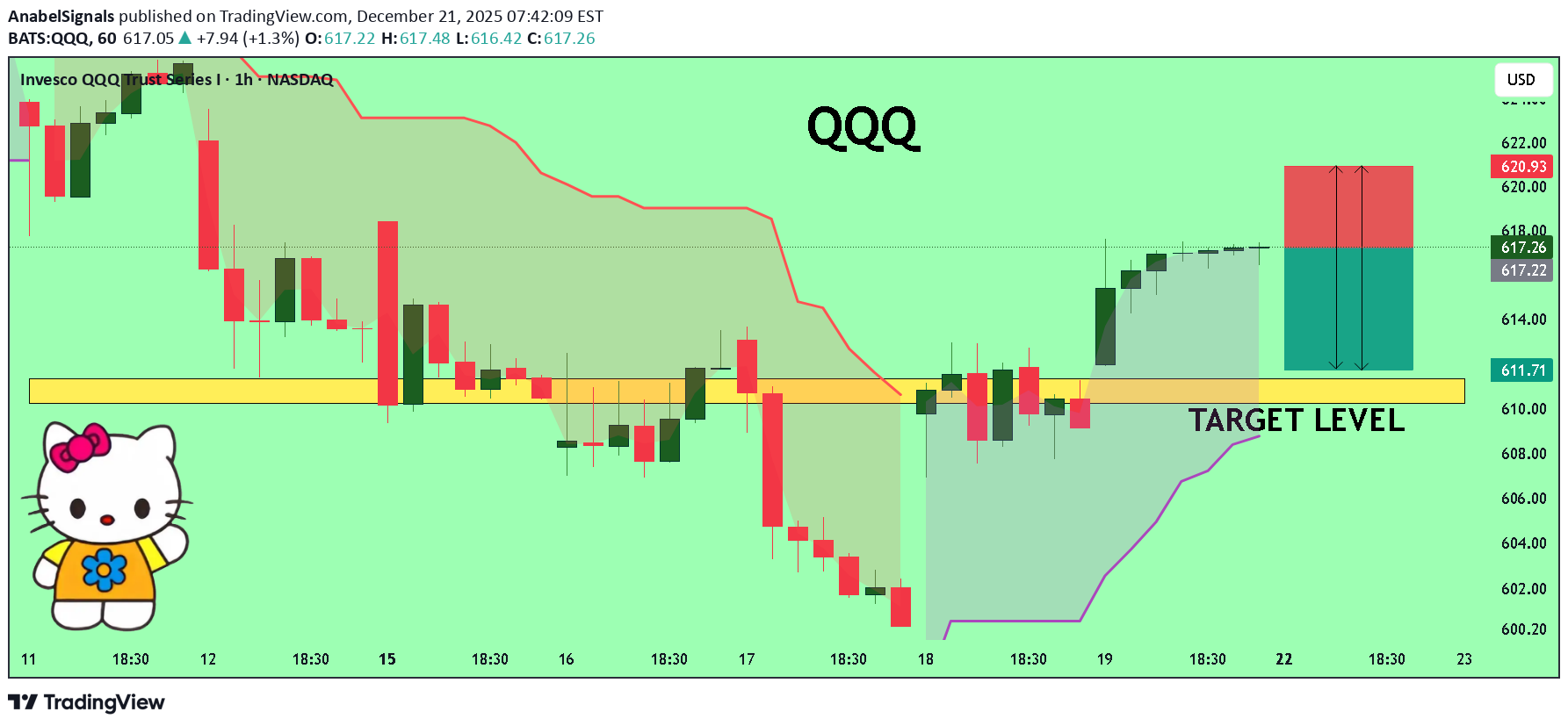
My dear followers, This is my opinion on the QQQ next move: The asset is approaching an important pivot point 617.26 Bias - Bearish Safe Stop Loss - 620.93 Technical Indicators: Supper Trend generates a clear short signal while Pivot Point HL is currently determining the overall Bearish trend of the market. Goal - 611.35 About Used Indicators: For more efficient signals, super-trend is used in combination with other indicators like Pivot Points. Disclosure: I am part of Trade Nation's Influencer program and receive a monthly fee for using their TradingView charts in my analysis. ——————————— WISH YOU ALL LUCK
Reading Market Intent vs Reacting to Price
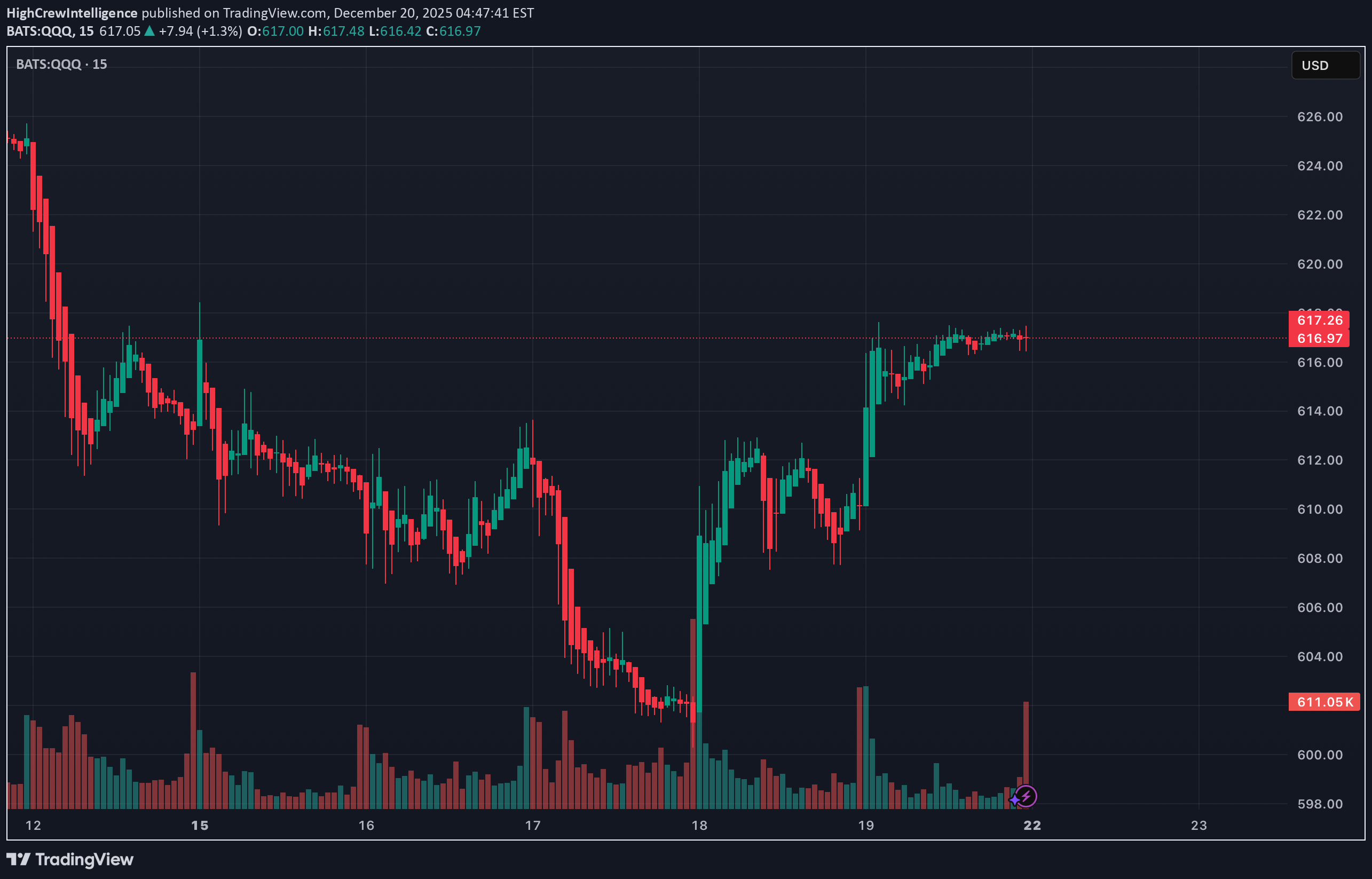
Most traders react to price. I focus on intent, the pressure that builds before price responds. That philosophy is what the HIGHCREW Intelligence System is built around. The RSI Scout Edition isn’t the engine. It’s a simplified lens that highlights when momentum is expanding or stalling so intent becomes visible instead of reactive. This is one layer of a broader intelligence framework — additional systems will be released over time.
Global Equity Markets Under Pressure: Causes and Consequences

Macroeconomic Headwinds Driving Market Stress One of the primary reasons global equities face pressure is the challenging macroeconomic backdrop. High inflation, tighter monetary policy, and slowing economic growth often converge to create an unfavorable environment for stocks. Central banks, led by the US Federal Reserve and followed by institutions such as the European Central Bank and the Bank of England, tend to raise interest rates to control inflation. While necessary, higher interest rates increase borrowing costs for businesses and consumers, reduce corporate profitability, and lower future earnings expectations. Since equity valuations are largely based on discounted future cash flows, rising rates directly weigh on stock prices. In addition, uneven global growth adds to market uncertainty. While some economies show resilience, others struggle with weak consumption, declining exports, or fiscal constraints. China’s growth fluctuations, Europe’s energy-related challenges, and the cyclical slowdown in parts of the US economy collectively affect global investor confidence. When growth expectations fall, equity markets usually reprice lower. Geopolitical Tensions and Global Uncertainty Geopolitical developments play a major role in putting pressure on global equities. Conflicts, trade disputes, sanctions, and diplomatic tensions disrupt supply chains, increase commodity prices, and create uncertainty about future economic stability. Markets dislike uncertainty more than bad news; when the outlook becomes unclear, investors often reduce exposure to risk assets like equities and shift towards safer instruments such as bonds, gold, or cash. Trade fragmentation and protectionist policies also impact multinational corporations. Many global companies rely on integrated supply chains and international markets for revenue growth. Any disruption or restriction increases costs and reduces margins, leading to downward revisions in earnings forecasts and, ultimately, lower stock prices. Corporate Earnings Under Strain Another key factor behind global equity pressure is the strain on corporate earnings. Rising input costs, higher wages, and expensive financing compress profit margins. Even companies with strong revenue growth may struggle to maintain profitability in such an environment. When quarterly earnings fail to meet expectations or forward guidance turns cautious, markets react swiftly and negatively. Moreover, currency fluctuations add another layer of complexity. A strong US dollar, for example, can hurt companies that earn a significant portion of their revenue overseas, as foreign earnings translate into fewer dollars. Emerging market companies may also face higher debt servicing costs if they have dollar-denominated liabilities, further affecting profitability and investor sentiment. Liquidity Tightening and Risk Appetite Global equity markets thrive on liquidity. When central banks reduce liquidity through quantitative tightening or balance sheet reductions, the flow of easy money into financial markets slows down. Lower liquidity means fewer buyers at higher prices, making markets more sensitive to negative news. As a result, even small disappointments can trigger sharp corrections. Risk appetite among investors also declines during such phases. Institutional investors, hedge funds, and retail participants become more selective, preferring quality stocks with strong balance sheets over speculative or highly leveraged companies. This shift often leads to broad market weakness, especially in high-growth sectors that depend heavily on future earnings. Sectoral Impact and Market Rotation Pressure on global equities does not affect all sectors equally. Technology and growth-oriented sectors are usually the most sensitive to rising interest rates because their valuations depend on long-term growth assumptions. Financials may face mixed outcomes, benefiting from higher interest margins but suffering from increased credit risk. Cyclical sectors such as metals, energy, and industrials often reflect concerns about slowing global demand. At the same time, defensive sectors like healthcare, utilities, and consumer staples tend to outperform during periods of equity market stress. This sectoral rotation reflects investors’ attempts to preserve capital rather than chase high returns. However, even defensive stocks may not be immune if broader market sentiment turns deeply negative. Emerging Markets and Capital Flows Emerging market equities often experience amplified pressure during global risk-off phases. Capital tends to flow out of emerging economies and into developed markets perceived as safer. This outflow weakens local currencies, increases inflationary pressure, and forces central banks to maintain higher interest rates, further slowing economic growth. Despite these challenges, emerging markets with strong fundamentals, improving reforms, and domestic demand-driven growth can show relative resilience. However, in the short term, global equity pressure usually leads to synchronized declines across most regions. Investor Psychology and Market Volatility Psychology plays a crucial role when global equities are under pressure. Fear, uncertainty, and negative headlines can create a self-reinforcing cycle of selling. As markets fall, investors worry about further losses and rush to exit positions, increasing volatility. Social media, algorithmic trading, and 24-hour news coverage amplify these reactions, making market moves sharper and faster than in the past. However, such periods of stress also lay the groundwork for future opportunities. Valuations become more attractive, weak hands exit the market, and long-term investors can gradually accumulate quality assets at discounted prices. The Road Ahead: Risks and Opportunities While global equities remain under pressure, the future path depends on several key variables. Inflation trends, central bank policy decisions, geopolitical stability, and corporate earnings growth will determine whether markets stabilize or face further downside. Any sign of easing inflation, rate cuts, or improved global coordination can quickly boost investor confidence. For investors, the focus should shift from short-term market noise to long-term fundamentals. Diversification across regions and asset classes, disciplined risk management, and patience become especially important during such phases. History shows that periods of equity market pressure, though uncomfortable, are a natural part of market cycles and often precede phases of recovery and growth. Conclusion Global equity markets under pressure reflect a complex mix of economic, political, and psychological factors. While the current environment may appear challenging, it is not unprecedented. Understanding the underlying drivers helps investors make informed decisions rather than emotional reactions. Ultimately, equity markets reward long-term discipline, and periods of stress often create the foundation for the next cycle of opportunity.
Market Signal

Market Signal is an algorithm that evaluates statistical trends in price action of QQQ and its holdings to determine whether QQQ is currently in an uptrend (📈) or downtrend (📉) Every day after market close, our Market Signal algorithm returns a numerical market sentiment value, ranging from -9 (most bearish) to +9 (most bullish), with 0 being a neutral score. 📈 QQQ is considered to be in an uptrend during consecutive days of positive Market Signal values 📉 QQQ is considered to be in a downtrend during consecutive days of negative Market Signal values See full screen chart -> tradingview.com/chart/nkwXX4Wx/

RonnieV29
Santa Rally / V-Shaped Recovery Watch

QQQ continues to respect the 50 & 100 DMA, just like every selloff since July. Momentum indicators are exiting oversold territory, suggesting a familiar upside rotation. SPY confirms. IWM remains structurally bullish on the monthly (cup & handle). BTC shows classic oversold mean reversion behavior. Key risk: loss of 100 DMA. Bias: upside continuation while support holds.
Hello trader, for today, QQQQ is at 609.01 in real-time pre-mark
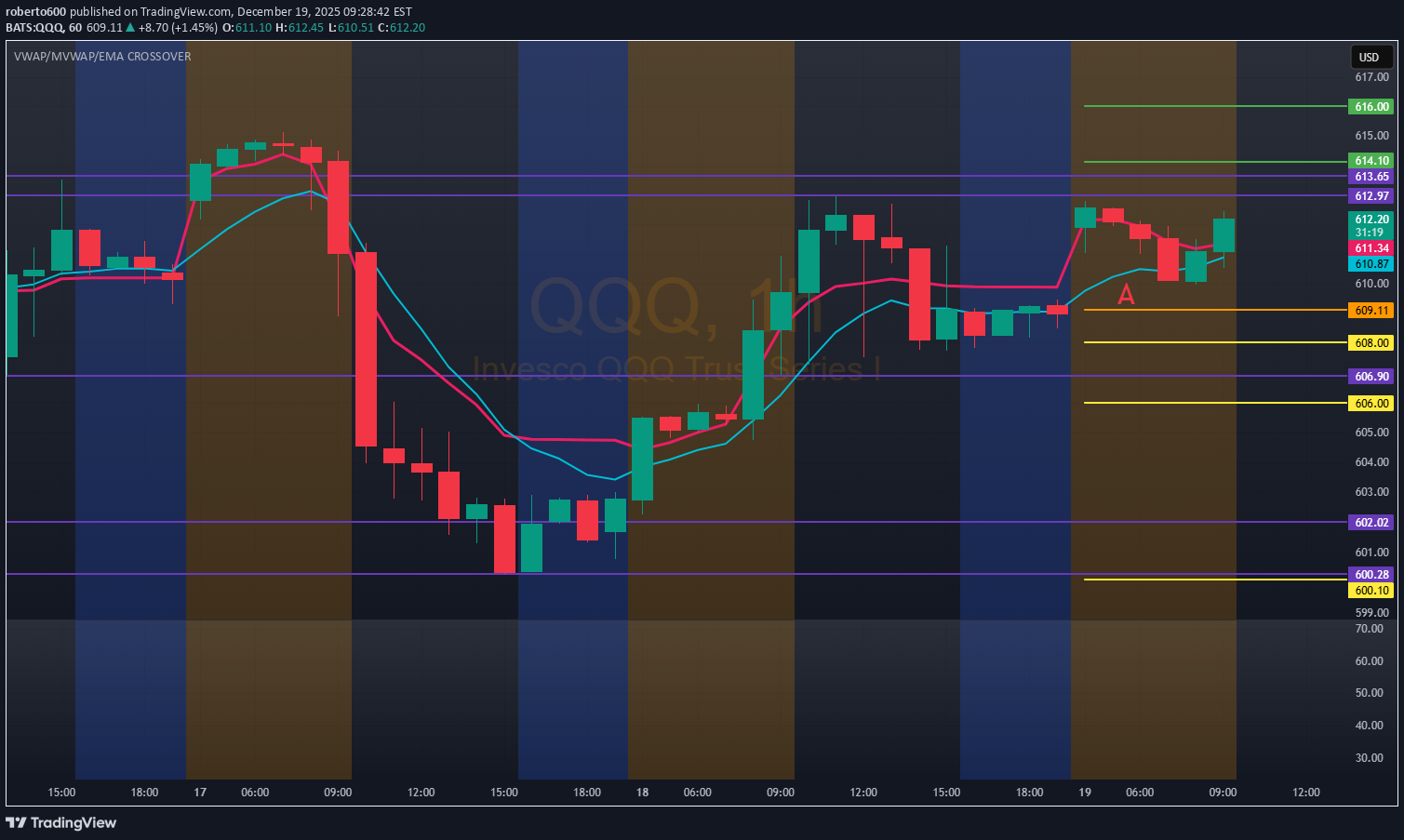
tradingview.com/chart/FvPElJ7r/ A bullish entry would be above 616.00 with a possible projection to the 628.00 area. Otherwise, our bearish entry should be below 606.00, potentially reaching the 600.00 area, which could be a reversal zone. Today is Friday, so we must be cautious of market traps. Have a good trading day.
Pitchfork up

Market should bounce here. Pitchfork analysis confirmed but multiple bounces. Inside pitchforks using the legs in February 2025, April 2025, October 2025, and November 2025

RonnieV29
MASSIVE RALLY OR MASSIVE CRASH...
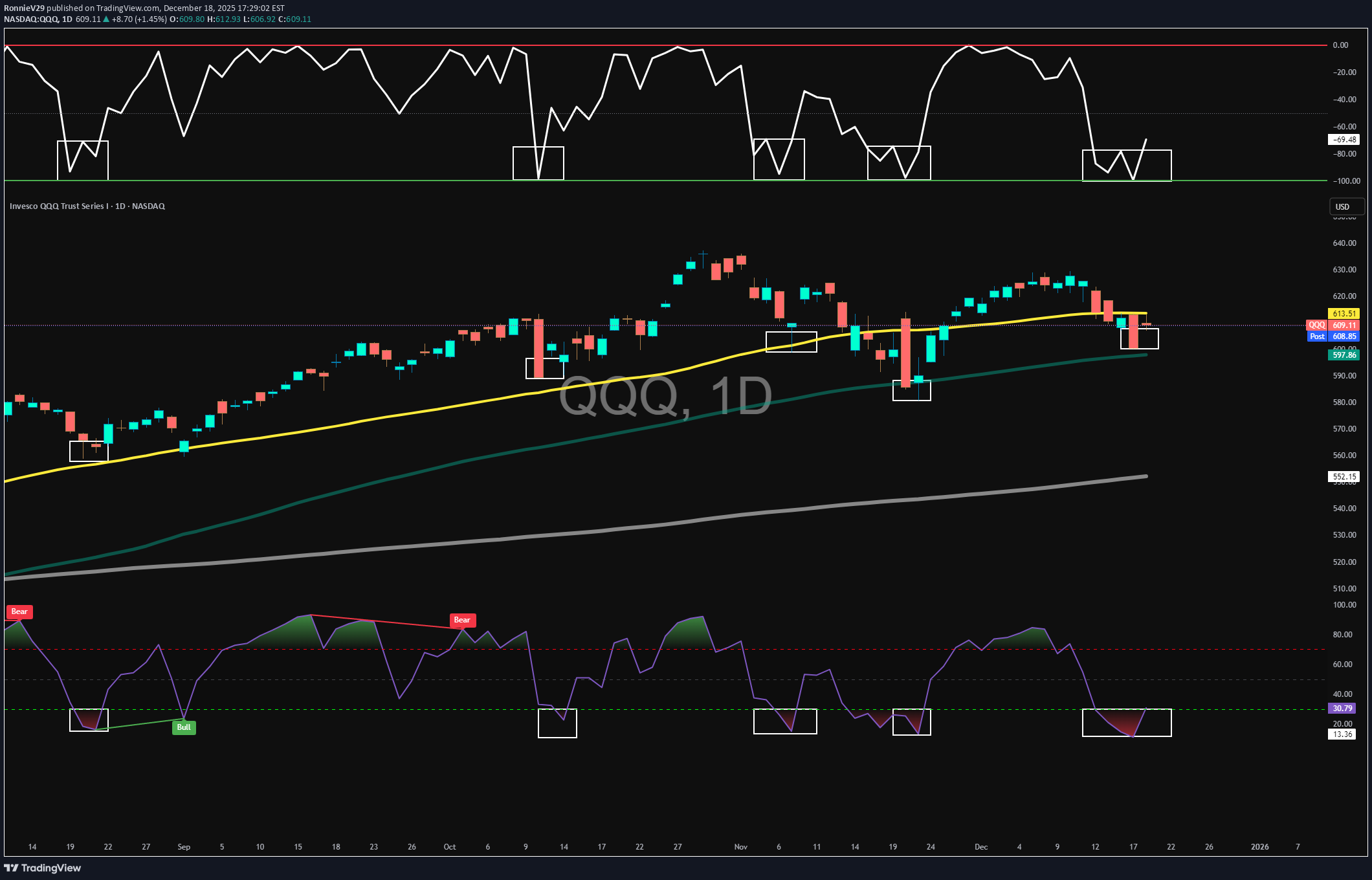
In this video we will talk about if the markets are in store for a MASSIVE RALLY OR MASSIVE CRASH... QQQ SPY IWM
Disclaimer
Any content and materials included in Sahmeto's website and official communication channels are a compilation of personal opinions and analyses and are not binding. They do not constitute any recommendation for buying, selling, entering or exiting the stock market and cryptocurrency market. Also, all news and analyses included in the website and channels are merely republished information from official and unofficial domestic and foreign sources, and it is obvious that users of the said content are responsible for following up and ensuring the authenticity and accuracy of the materials. Therefore, while disclaiming responsibility, it is declared that the responsibility for any decision-making, action, and potential profit and loss in the capital market and cryptocurrency market lies with the trader.


